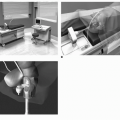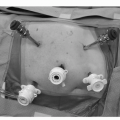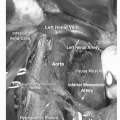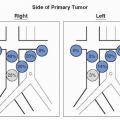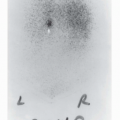Screening, Early Detection, and Prevention of Bladder Cancer
Antonio J. Otero
H. Barton Grossman
Colin P.N. Dinney
SCREENING AND EARLY DETECTION
Bladder cancer is the fourth most common cancer in men and the seventh most common cause of cancer death in men in the United States. In women, bladder cancer is much less common but has a higher incidence and mortality relative to cervical cancer, for which screening is widely practiced. An estimated 70,980 new cases of bladder cancer were diagnosed in 2009, with an estimated 14,330 deaths (1). Bladder cancer also remains the most costly malignancy to treat over the life of the patient (2). The lifetime probability of developing bladder cancer, based on statistical modeling and available databases between 2003 and 2005, is 3.74% (1 in 27) for men and 1.18% (1 in 84) for women—a rise in comparison to a similar analysis from 1997 to 1999 (1). The vast majority of patients with newly diagnosed bladder cancers have non-muscle-invasive neoplasms with an excellent prognosis. However, 40% to 70% of tumors recur and may progress to invasive cancers in 5% to 40% of patients (3,4,5,6). For this reason, patients with bladder cancer are closely monitored with cystoscopy and urine-based tests to detect recurrence and progression and enable early therapeutic intervention. The risk of tumor recurrence is related to several tumoral factors including tumor grade, tumor stage, and cystoscopic findings at the first 3-month follow-up cystoscopy. Leading clinical risk factors for recurrence include cigarette smoking, aromatic amine exposure, and chemical exposures (7,8,9). Patients at high risk for recurrence and progression are often treated with intravesical chemotherapy or immunotherapy to lower their risks. Since bladder cancer is rarely found incidentally at autopsy and has high patient and societal costs, it may be a worthwhile malignancy in which to pursue a clinical strategy of early detection and prevention. Wilson and Jugner proposed several principles that a given disease should have in order for screening to be a good public health policy (10). The National Cancer Institute (11), the World Health Organization, and other Public Health entities have refined these criteria, but the underlying conditions remain unchanged: (a) The disease represents an important health problem. (b) There should be a preclinical/presymptomatic state more amenable to treatment. (c) The natural history of the disease should be understood. (d) There should be an acceptable screening test. (e) There should be an acceptable and effective treatment. In the case of bladder cancer, points (c) and (d) are the most contentious. However, the rarity of incidental bladder cancer at autopsy suggests it is not an indolent disease, even when nonmuscle invasive.
Noninvasive papillary disease (Ta) is usually more of a “nuisance” than a threat to the patient, as the risk of recurrence far outweighs the risk of progression. Invasive, high-grade tumors portend a poorer outcome despite aggressive treatment. Most patients with muscle-invasive disease present as such, and 80% of patients with invasive disease have no history of superficial tumors (12,13). Death from bladder cancer rarely occurs in the absence of metastatic disease, and metastatic disease rarely occurs in the absence of muscle invasion (14). Therefore, early detection, while the tumor is confined to the superficial layers of the bladder, should decrease bladder cancer mortality.
Ideally, screening and early detection tools should be relatively inexpensive, easy to use, minimally invasive; provide reproducible results; and have acceptable performance characteristics. “Sensitivity,” defined as the percentage of patients with the disease for whom the test is positive, should approach 100%. “Specificity,” defined as the percentage of patients without the disease for whom the test is negative, should also approach 100%. Although it is not realistic to achieve complete accuracy in detecting bladder cancer, minimizing false-positive and false-negative rates is important. Typically, as sensitivity improves, specificity decreases. Combining a highly sensitive test for screening with a confirmatory test showing high specificity is a technique employed in other diseases, for example, PSA followed by prostate biopsy. In addition to sensitivity and specificity, the positive and negative predictive values of the test must be considered. These parameters are influenced by the prevalence of the disease in the population. A test may perform relatively well in a selected population, for example, patients with a history of bladder cancer, but have low positive predictive value for population-based screening. Tests with high positive predictive value can be used to initiate an intervention to diagnose and treat bladder cancer. On the other hand, tests with high negative predictive value can be used to indicate that aggressive surveillance is not necessary.
Screening Studies
General screening for bladder cancer is associated with several practical problems. With a population-based incidence rate of <3% and a preponderance of noninvasive low-grade tumors, demonstrating a reduction in bladder cancer mortality would require massive screening efforts and high costs. Most early detection studies have focused on high-risk individuals, namely patients with a prior history of bladder cancer. The term screening, however, should be reserved for patients with no history of the disease, and the terms early detection and surveillance should be used to characterize detection of recurrent bladder cancer.
The gold standard for diagnosing bladder cancer is cystoscopy. However, this standard is flawed. Whereas it has long been recognized that cystoscopy can fail to detect carcinoma in situ, recent experiments with fluorescence cystoscopy demonstrate that papillary tumors can also escape conventional cystoscopic detection (15). Current bladder cancer surveillance protocols are based on cystoscopic evaluation as frequently as every 3 months. The examination is invasive, relatively expensive, operator dependent, and often a source of patient anxiety. Additionally, patient and physician compliance with cystoscopy
is often suboptimal (16). These concerns have driven the search for noninvasive screening and detection tools.
is often suboptimal (16). These concerns have driven the search for noninvasive screening and detection tools.
The two most commonly used tests for bladder cancer screening and surveillance are urinalysis for hematuria and urinary cytology. Both tests have inherent strengths and weaknesses and are often combined with other investigations to maximize bladder cancer detection. Neither test is an ideal screening tool, but rather a means of directing further diagnostic evaluation.
Hematuria is present in virtually all cases of cystoscopically detectable bladder cancer, and painless hematuria is noted in 85% of patients (17). The current methods of detecting hematuria are sensitive, inexpensive, and reproducible. These methods include microscopic examination of the urinary sediment and dipstick analysis of the uncentrifuged specimen. Microscopic analysis, although technically more demanding, costlier, and more time consuming, avoids the potential false-positives caused by hemoglobinuria and myoglobinuria. Multiple nonmalignant conditions can produce hematuria and contribute to the poor specificity of this test in bladder cancer detection. In fact, only about 8% of patients with hematuria on dipstick analysis have bladder cancer (18).
Urine cytology is performed by microscopic assessment of shed urothelial cells. High-grade malignant cells have a characteristic appearance and can be readily differentiated from normal urothelium; however, low-grade bladder cancers are more difficult to detect. Most contemporary series report sensitivities in the 70% to 85% range for high-grade tumors and in the 30% to 40% range for low-grade tumors (19). With an experienced observer, the specificity of cytology is excellent, with published values typically exceeding 90% (20, 21). However, the use of urine cytology as a screening test for bladder cancer is hindered by its poor sensitivity. It is used in the surveillance of patients with a history of bladder cancer as an indicator of occult carcinoma in situ.
Several studies have addressed the issue of screening in asymptomatic populations. Britton et al. (22) evaluated the efficacy of urine dipsticks in the early detection of bladder cancer in a group of men from Leeds, England. A group of 2,356 asymptomatic men over 60 years of age were evaluated at baseline with dipstick urinalysis followed by weekly home dipstick testing for 10 weeks. Of this group, 474 (20.1%) were found to have hematuria; of these 474 men, 295 (12.5%) had hematuria identified at the initial screening evaluation, and 179 (7.6%) had at least one positive test during the subsequent period of home testing. Only 265 of the 474 patients completed the urologic evaluation. Bladder tumors were diagnosed in 17 patients and were subsequently treated. Abnormal urine cytology was found in 10 of the 17 patients. The authors concluded that urine dipstick testing provided an inexpensive, simple, and acceptable test for bladder cancer and acknowledged that this screening method produced large numbers of patients with false-positive test results for whom additional evaluation was necessary. They proposed the addition of urine cytology to this screening strategy. In an update, the authors also noted a lower progression rate versus nonscreened populations, providing a compelling argument for randomized prospective screening trials (23).
In a similar study, Messing et al. (18,24,25) screened 1,575 asymptomatic men 50 years or older for bladder cancer with home dipstick testing. The participants tested their urine daily for 14 consecutive days and repeated this at 9 months if the initial set was negative. 258 men (16.4%) with at least one positive test were considered appropriate for evaluation (no other explained cause of hematuria). Of these patients, 25 (9.7%) were found to harbor urologic cancers, 21 of which were transitional cell carcinoma of the bladder and 4 renal cell carcinomas. The authors also noted that 19 of 21 men who had bladder cancer detected had a history of smoking, as compared to 59.9% of the entire cohort. These authors concluded that home screening for hematuria was a feasible and economical tool for the early detection of urinary tract cancers and other diseases and that the quantity and frequency of hematuria were not related to disease severity. This study had a total follow-up of 14 years and noted no mortalities in the screening group. The proportion of advanced stage cancers (T2 or higher) was significantly lower in the screening group. Caution should be practiced when interpreting this nonrandomized study. A critique by Cai et al. (26) noted that the PPV and detection rate were low, 8.9% and 1.33%, respectively (21 patients with bladder cancer, 1,575 screened men). A detailed cost-estimate analysis by Lotan et al. calculated that an incidence of about 1.6% is necessary for screening to be cost effective (27); therefore, the incidence of 1.33% in this population is near the threshold.
Screening studies in high-risk groups have yielded promising results as well. Theriault et al. (28) evaluated a bladder screening protocol (using annual urinary cytology) among aluminum production workers in Quebec who were exposed to coal-tar-pitch volatiles, a known bladder carcinogen. Cases detected after the screening program was introduced (1980s) were compared to cases diagnosed earlier (1970s). The proportion of cases identified at earlier stages favored the screening group with a trend toward improved survival. Although tumor grade did not appear to differ, the percentage of superficial lesions diagnosed in the screening group was 63% compared with 39% in the nonscreened group.
Mason et al. (29) evaluated a home self-test for microscopic hematuria in a group of subjects working at the DuPont Chambers Works in Deepwater, New Jersey. These workers were exposed to β-naphthylamine, benzidine, and other suspected bladder cancer carcinogens. Every 6 months, subjects tested their urine at home for 14 consecutive days for the presence of blood. In addition, urine cytologies were periodically performed. Through the first seven periods of screening, two new cases and one recurrence of transitional cell carcinoma of the bladder were detected.
Marsh et al. (30) reported the 15-year bladder cancer screening results from the Drake Health Registry Study (DHRS). This study was initiated in 1986 by the University of Pittsburgh to screen employees of the Drake Chemical Company in Lock Haven, Pennsylvania. Workers employed by the company had been exposed to β-naphthylamine. In a previous cohort analysis, Marsh et al. (31) found a 20- to 30-fold excess bladder cancer mortality risk in this patient population. DHRS participants were screened annually with urinalysis for hematuria, Papanicolaou cytology, and quantitative fluorescence image analysis. Newer biomarkers, including M344 and G-actin, were added in 1995. Over the course of 15 years, DHRS screened over 350 individuals and identified 51 people eligible for further diagnostic evaluation. Of 41 people who underwent cystoscopy, 1 was diagnosed with carcinoma in situ, 2 with transitional cell papilloma, 14 with dysplasia, and 2 with transitional cell carcinoma. Bladder abnormalities such as chronic cystitis, atypia, and hyperplasia were identified in 26 individuals. The authors concluded that the DHRS identified early-stage bladder cancer and other abnormalities among workers exposed to β-naphthylamine. In addition, they emphasized the importance of ongoing screening in these patients, as the median latency period for this cohort (including cases detected prior to screening) was 25 years.
Steiner et al. conducted a small screening study in high-risk smokers (40 pack-years or more) in Austria and published preliminary results (32). A total of 183 patients had urine dipstick, NMP22, UroVysion, and urine cytology analysis performed. Seventy-five patients had at least one abnormal test
result and underwent additional testing, which discovered malignancies in six patients (3.3% of population), including two patients with upper tract urothelial carcinomas and one with a renal cell carcinoma. None of the tests detected all of the malignant lesions. The study concluded that a combination of UroVysion, cytology, and urine dipstick would be the most efficient combination to use for screening. Uro-Screen, a German study in chemical workers exposed to aromatic amines, has recently presented interim data (33). It used three urine-based markers (UBMs) in addition to cytology and hematuria evaluation, NMP22, UroVysion, and survivin. In the 1,556 workers, 15 tumors have been found. The NMP22, UroVysion, and survivin tests were positive in 166, 48, and 62 urine samples, respectively. In 5 of the 15 patients with tumors, no markers were positive.
result and underwent additional testing, which discovered malignancies in six patients (3.3% of population), including two patients with upper tract urothelial carcinomas and one with a renal cell carcinoma. None of the tests detected all of the malignant lesions. The study concluded that a combination of UroVysion, cytology, and urine dipstick would be the most efficient combination to use for screening. Uro-Screen, a German study in chemical workers exposed to aromatic amines, has recently presented interim data (33). It used three urine-based markers (UBMs) in addition to cytology and hematuria evaluation, NMP22, UroVysion, and survivin. In the 1,556 workers, 15 tumors have been found. The NMP22, UroVysion, and survivin tests were positive in 166, 48, and 62 urine samples, respectively. In 5 of the 15 patients with tumors, no markers were positive.
Assessment of benefit in the targeted studies is limited due to the lack of randomized controlled trials. The data suggest that screening can detect bladder cancers at lower stages. Nevertheless, the optimal populations to screen and the method of screening them have not been defined. Furthermore, convincing evidence that screening for bladder cancer improves patient outcome is lacking. It should be noted that a mass screening program in Japan for neuroblastoma yielded no improvement in cause specific mortality (34).
Urine-Based Markers for Screening
The recent emergence of sensitive markers for bladder cancer has provided new opportunities for early bladder cancer detection. There are currently more than 20 UBMs in various stages of development, in addition to urine cytology and urine hemoglobin. A comprehensive review of all UBMs is beyond the scope of this chapter. Evaluation of these markers has been conducted almost exclusively in patients with bladder cancer or patients presenting with signs and symptoms of bladder cancer. Assays currently FDA approved in the United States include BTA stat, BTA TRAK, ImmunoCyt, NMP22, NMP22 BladderChek, and UroVysion. NMP22 and UroVysion are approved for the detection of primary bladder cancer. The others are approved for the detection of recurrent bladder cancer. Urine cytology has been used in the detection of bladder cancer for over 60 years (35). It is operator dependent and is considered a poor test in low-grade tumors. Sensitivity ranges from 30% to 60% with specificity from 90% to 100% (36,37).
The BTA stat and the TRAK tests are immunoassays that recognize human complement factor H-related protein, a protein produced by several bladder cancer cell lines and found in the urine of patients with transitional cell bladder cancer (38). These assays differ from the original BTA test, a latex agglutination test designed to detect a basement membrane protein antigen (bladder tumor antigen) released into the urine of patients with bladder cancer. The original BTA test is no longer used in the United States. BTA stat is a qualitative point-of-care test, whereas BTA TRAK is quantitative and requires laboratory analysis. Most published series report the sensitivity for both tests as 60% to 70% and the specificity as 50% to 85% (36,37,39,40). BTA stat and BTA TRAK have not been studied as screening agents in healthy populations; however, they have been studied in healthy control groups to assess specificity (40,41,42). The tests suffer from low specificity in the setting of inflammation, prostatic hyperplasia, or other conditions that cause hematuria.
NMP22 detects a nuclear mitotic apparatus protein that is an abundant component of the nuclear matrix. This protein is released from cancer cells during cell death and detected by an enzyme-linked immunoassay that uses two monoclonal antibodies. NMP22 is a quantitative test with reported sensitivity and specificity of 60% to 75% and 70% to 85%, respectively (40,43,44). NMP22 BladderChek is a point-of-care assay. This test has been used to screen a high-risk population in Dallas, Texas, based on smoking history (86% of participants) or occupational exposures (45). The trial enrolled 1,502 patients, including 327 women. The patients had an NMP22 BladderChek test performed at entry with additional evaluation if positive. Eighty-five patients (5.5%) had a positive test, and sixty-nine agreed to further evaluation, leading to a diagnosis of two patients with malignancy (Ta, low grade and Ta, high grade) and one with marked atypia, yielding a PPV of 2.4%. The patients with negative studies were recontacted at 12 months to assess the development of bladder cancer. Follow-up was available in 1,309 participants, and two additional Ta, low-grade tumors were found. The trial noted that 73% of study participants had a urinalysis within 3 years prior to study entry. The low incidence of bladder cancer in this high-risk population suggests that routine urinalysis may be effective in detecting bladder cancer.
The ImmunoCyt test combines an immunofluorescence assay with urinary cytology. Using three monoclonal antibodies, the test detects a high molecular weight glycosylated form of carcinoma embryonic antigen and several mucins that are expressed preferentially on bladder cancer cells. The reported sensitivity and specificity is 38% to 95% and 76% to 84%, respectively (46,47,48). In a comparison with UroVysion and cytology testing in 100 patients with a history of bladder cancer who underwent cystoscopy immediately after urine collection, the ImmunoCyt test showed a 62% and 91% sensitivity for low-grade and high-grade tumors, respectively. Specificity was 67%, lower than both cytology and UroVysion (49). ImmunoCyt is operator and lab dependent; concordance rates ranged from 87% to 100% in patients with a tumor to 56% to 89% in those without (50,51).
Uro Vysion is a fluorescence in situ hybridization (FISH) test composed of three chromosome enumeration probes (CEP17, CEP3, and CEP7) and a single locus-specific indicator probe (9p21). Bladder cancers are associated with a number of cytogenetic changes, including increased copy numbers of chromosomes. UroVysion has a reported sensitivity of 71% to 98% and a specificity from 85% to 96% (52,53). It is FDA approved not only in patients with a history of bladder cancer, but also in patients with hematuria. Several studies have performed “reflex” UroVysion testing in patients with suspicious cytology or abnormal cystoscopy (54,55) showing that the test is useful in that clinical setting. In 275 healthy volunteers or patients without a history of bladder cancer, the test was negative in 260 (94.5% specificity) (53).
There are a number of UBMs in development. Microsatellite assays detect genomic instability by comparing DNA from tumor cells with normal cells, for example, shed urothelial carcinoma cells with peripheral blood lymphocytes. The loss of heterozygosity indicates a specific locus where a tumor suppressor gene may be present. Using multiple microsatellite markers, the likelihood of detecting a malignancy can be improved. Sidransky et al. (56) tested 13 microsatellite markers in the urine of 25 patients presenting with signs and symptoms suggestive of bladder cancer. Genetic alterations were detected in 19 of 20 patients who were subsequently found to have histologically confirmed bladder cancer. Five patients without neoplasia (controls) did not show any microsatellite changes.
Malignant cells frequently show changes in chromosomal number. Aurora kinase A (AURKA), a serine/threonine kinase involved in chromosomal segregation, is upregulated in bladder cancer (57,58). A study examining the performance characteristics of a FISH assay measuring AURKA demonstrated a
sensitivity of 87% and a specificity of 96% (59). Tables 18.1 and 18.2 present the test and performance characteristics outlined above as well as those of other select UBMs.
sensitivity of 87% and a specificity of 96% (59). Tables 18.1 and 18.2 present the test and performance characteristics outlined above as well as those of other select UBMs.
TABLE 18.1 CURRENTLY AVAILABLE UBMS FOR BLADDER CANCER | ||||||||||||||||||||||||||||||||||||||||||||||||||||||
|---|---|---|---|---|---|---|---|---|---|---|---|---|---|---|---|---|---|---|---|---|---|---|---|---|---|---|---|---|---|---|---|---|---|---|---|---|---|---|---|---|---|---|---|---|---|---|---|---|---|---|---|---|---|---|
| ||||||||||||||||||||||||||||||||||||||||||||||||||||||
Stay updated, free articles. Join our Telegram channel

Full access? Get Clinical Tree


